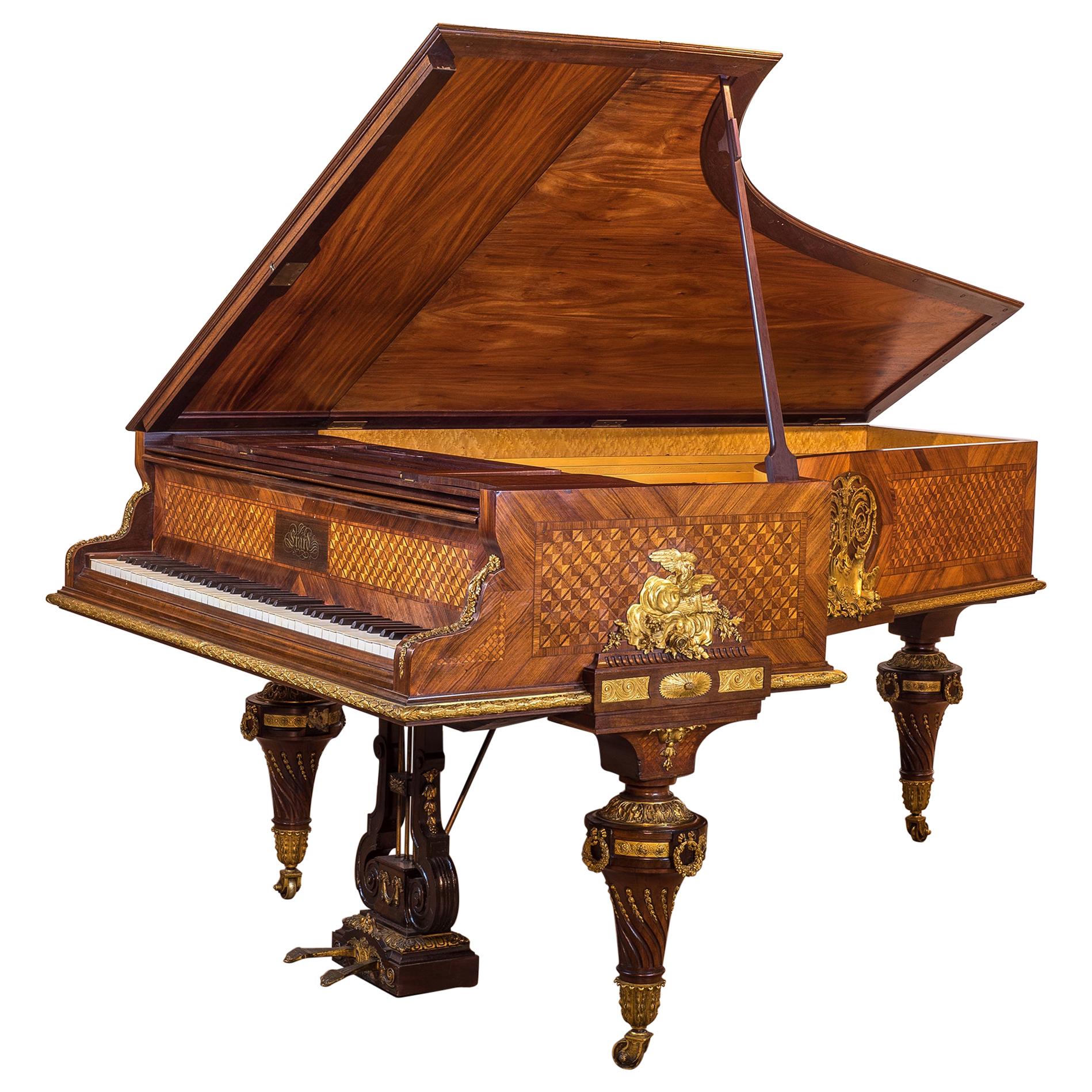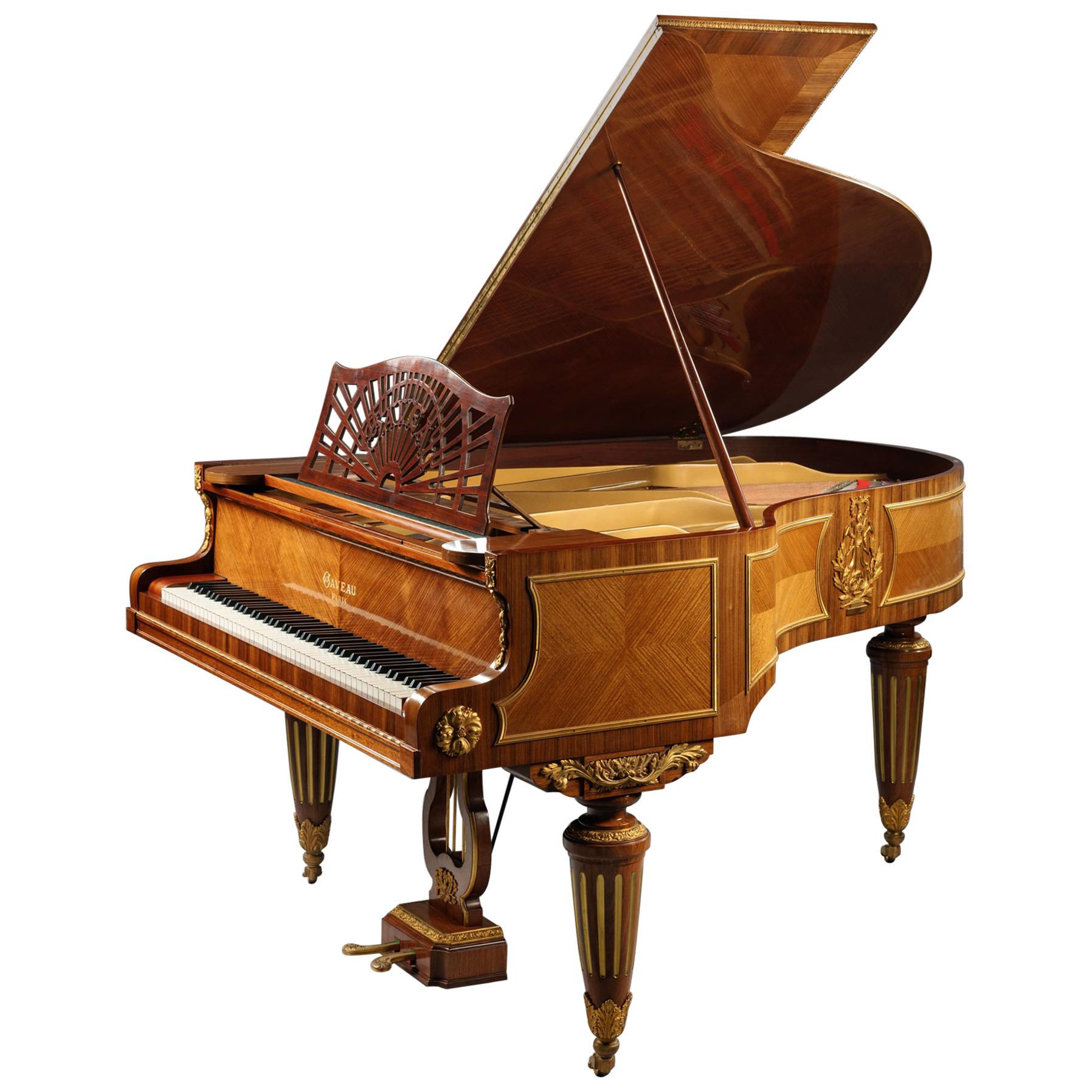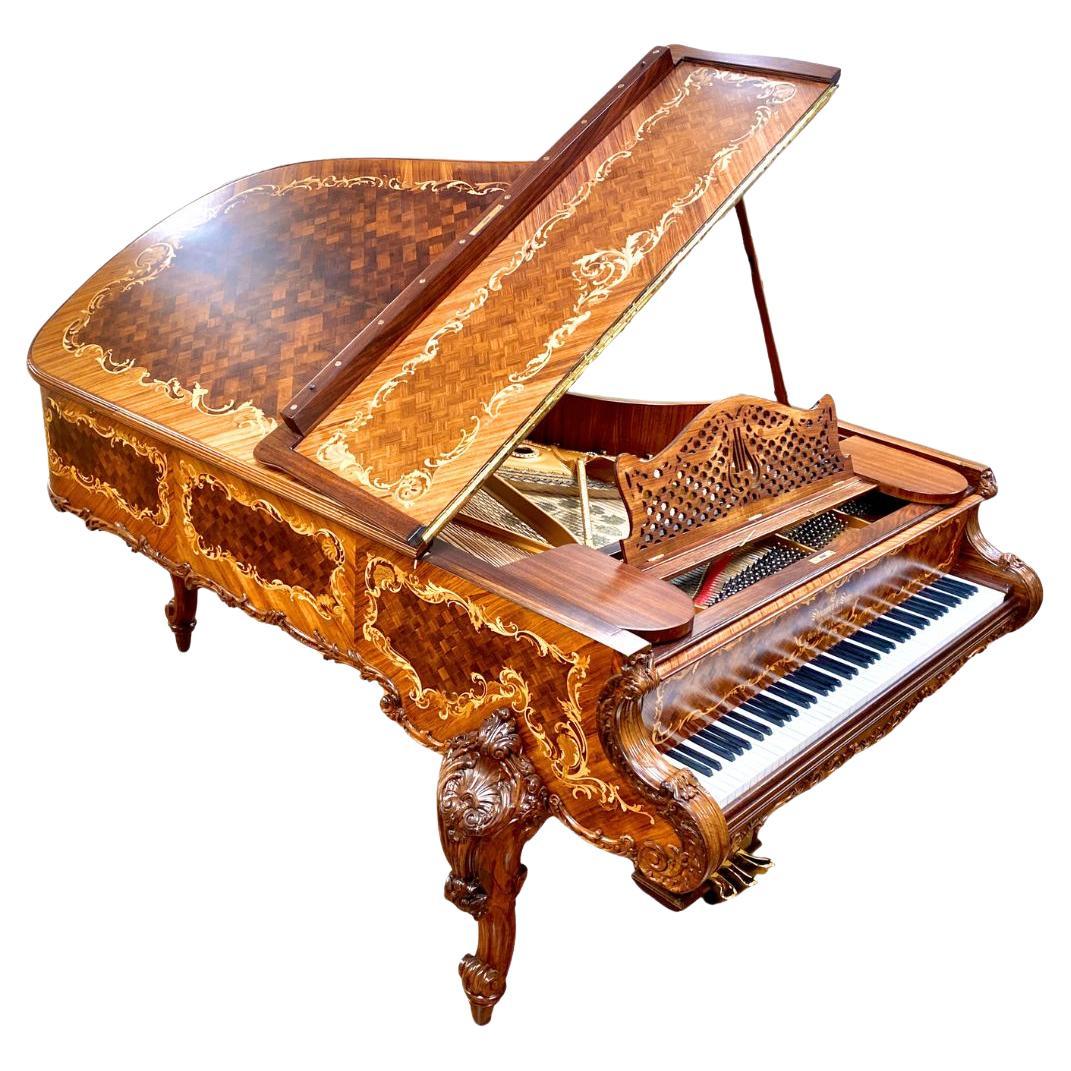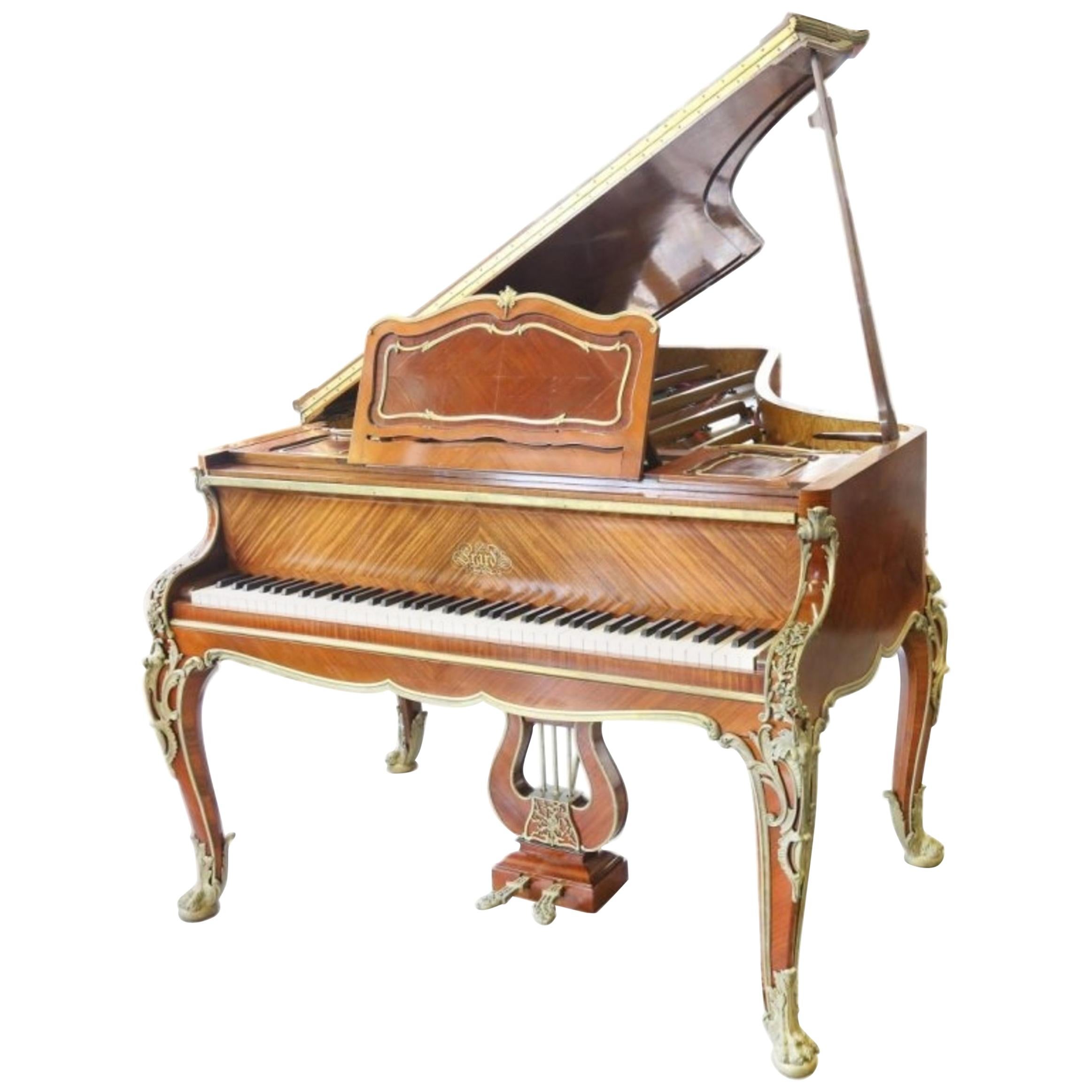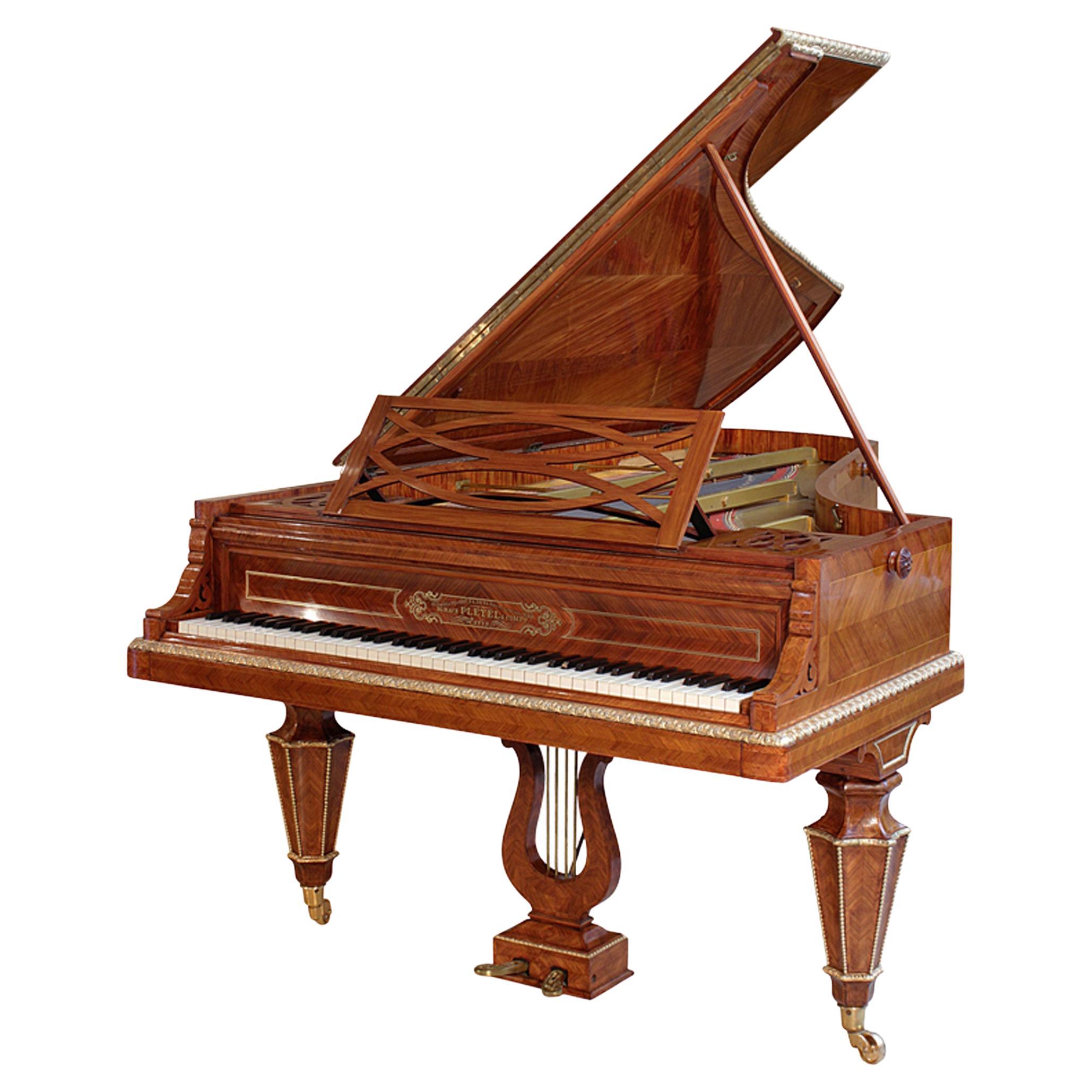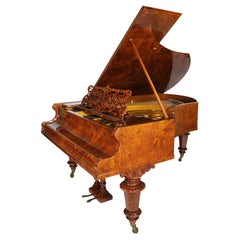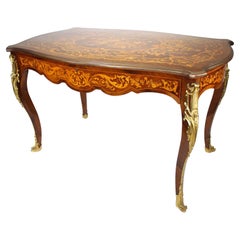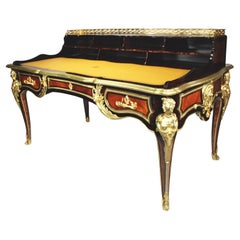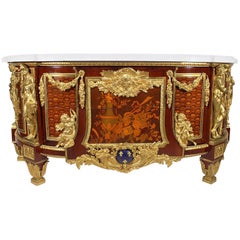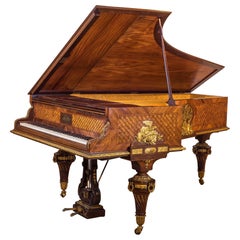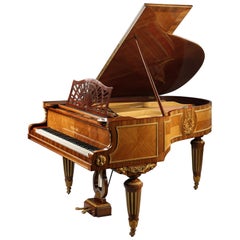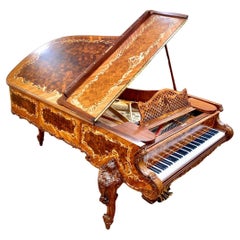Items Similar to 19th Century Louis XIV Style Marquetry Baby Grand Piano by Collard & Collard
Want more images or videos?
Request additional images or videos from the seller
1 of 11
19th Century Louis XIV Style Marquetry Baby Grand Piano by Collard & Collard
$75,600
$94,50020% Off
£57,420.06
£71,775.0820% Off
€66,043.57
€82,554.4720% Off
CA$105,628.02
CA$132,035.0220% Off
A$117,787.19
A$147,233.9920% Off
CHF 61,456.34
CHF 76,820.4220% Off
MX$1,445,293.25
MX$1,806,616.5620% Off
NOK 782,241.25
NOK 977,801.5620% Off
SEK 741,156.59
SEK 926,445.7420% Off
DKK 492,907.62
DKK 616,134.5220% Off
Shipping
Retrieving quote...The 1stDibs Promise:
Authenticity Guarantee,
Money-Back Guarantee,
24-Hour Cancellation
About the Item
A very fine Anglo-French 19th century rosewood, palisander, amboyna and satinwood marquetry (inlaid) art-case baby grand piano, the works by "Collard & Collard". The intricately decorated marquetry top, sides and keyboard cover with designs of exotic flowers, floral bouquets and arrangements, acanthus, fruits and leaves, raised on three square legs with gilt bronze casters. The music board casted with the "Collard & Collard" logo, K-3 and stamped "H. Hinton". The same logo, but in marquetry, under the keyboard cover. The under case stamped "324", circa 1875-1900.
Serial number: 142091
Collard & Collard - Frederick William Collard (baptised 1772, died 1860) was a British piano manufacturer.
Collard, son of William and Thamosin Collard, was baptised at Wiveliscombe, Somerset, on 21 June 1772, and coming to London at the age of fourteen, obtained a situation in the house of Longman, Lukey, & Broderip, music publishers and pianoforte makers at 26 Cheapside.
In 1799 Longman & Co. fell into commercial difficulties, and a new company, consisting of John Longman, Muzio Clementi, Frederick Augustus Hyde, F. W. Collard, Josiah Banger, and David Davis, took over the business, but on 28 June 1800 Longman and Hyde retired, and the firm henceforth was known as Muzio Clementi & Co. After some time William Frederick Collard was admitted a partner, and on 24 June 1817 Banger went out. On 24 June 1831 the partnership between F. W. Collard, W. F. Collard, and Clementi expired, and the two brothers continued the business until 24 June 1842, when W. F. Collard retired, and F. W. Collard, then sole proprietor, took into partnership his two nephews, Frederick William Collard, jun., and Charles Lukey Collard.
After 1832 the pianos which had long borne the name of Clementi began to be called Collard & Collard, and many patents were in course of time taken out for improvements both in the action and the frame of the instruments. The firm soon gave up the business of music publishing, and confined themselves to pianoforte making, except that they had also the contract for supplying bugles, fifes, and drums to the regiments of the East India Company until 1858, when the government of India was transferred to the queen. About this time a novelty was brought out, which was suggested by an article in Chambers's Journal, a piano of the cottage class styled pianoforte for the people, which was sold in considerable numbers. To the Great Exhibition of 1851 Collard sent a grand, for which the musical jury awarded the council medal, but this award was not confirmed, owing to some feeling of jealousy.
The firm suffered twice from large fires; on 20 March 1807 the manufactory in Tottenham Court Road was burnt to the ground, and on 10 Dec. 1851 a new manufactory in Oval Road, Camden Town, was entirely destroyed.
F. W. Collard died at 26 Cheapside on 31 Jan. 1860, aged 88, having always lived in the same house since his arrival in London in 1786.
William Frederick Collard, the brother and partner of the above, was baptised at Wiveliscombe on 25 Aug. 1776, and, in addition to an inventive genius respecting improvements in pianos, also developed a taste for lyric poetry. He retired from business in 1842, and died at Folkestone on 11 Oct. 1866.
Length: 72 inches (182.9 cm)
Width: 55 1/2 inches (141 cm)
Height (Top Closed): 40 1/4 inches (102.2 cm).
- Creator:Collard & Collard (Manufacturer)
- Dimensions:Height: 40.25 in (102.24 cm)Width: 72 in (182.88 cm)Depth: 55.5 in (140.97 cm)
- Style:Neoclassical Revival (In the Style Of)
- Materials and Techniques:
- Place of Origin:
- Period:
- Date of Manufacture:circa 1875-1900
- Condition:Repaired: The art-case has had previous restorations on the veneer with current under-lacquer craquelure and touch-ups, in overall fair to good used condition. Wear consistent with age and use. Minor losses. Minor fading. A truly great looking piano. I used condition with some old touch-ups & restorations throughout the case, age stress hair-lines (touched-up) & craquelure on veneer, mainly on the sides, It will require some fine tuning at destination at buyers cost.
- Seller Location:Los Angeles, CA
- Reference Number:Seller: Ref.: A22351stDibs: LU179628392003
About the Seller
5.0
Vetted Professional Seller
Every seller passes strict standards for authenticity and reliability
Established in 1982
1stDibs seller since 2016
133 sales on 1stDibs
Typical response time: 1 hour
- ShippingRetrieving quote...Shipping from: Los Angeles, CA
- Return Policy
Authenticity Guarantee
In the unlikely event there’s an issue with an item’s authenticity, contact us within 1 year for a full refund. DetailsMoney-Back Guarantee
If your item is not as described, is damaged in transit, or does not arrive, contact us within 7 days for a full refund. Details24-Hour Cancellation
You have a 24-hour grace period in which to reconsider your purchase, with no questions asked.Vetted Professional Sellers
Our world-class sellers must adhere to strict standards for service and quality, maintaining the integrity of our listings.Price-Match Guarantee
If you find that a seller listed the same item for a lower price elsewhere, we’ll match it.Trusted Global Delivery
Our best-in-class carrier network provides specialized shipping options worldwide, including custom delivery.More From This Seller
View AllA German 19th Century Louis XVI Style Burr Walnut Bechstein Concert Grand Piano
By Bechstein Piano Company
Located in Los Angeles, CA
A Very Fine German 19th Century Louis XVI Style Burr Walnut Bechstein Concert Grand Piano, Serial No. 5655. The beautifully crafted Grand piano, raised on three tapered barrel shaped legs, with an intricately carved ornate music desk and original keys. Circa: 1872.
Length: 80 inches (203.2 cm)
Width: 59 inches: (149.9 cm)
Height (top closed): 38 5/8 inches (98.1 cm)
C. Bechstein Pianofortefabrik
C. Bechstein Pianofortefabrik AG (also known as Bechstein) is a German manufacturer of pianos, established in 1853 by Carl Bechstein.
Before Bechstein
Young Carl Bechstein studied and worked in France and England as a piano craftsman, before he became an independent piano maker. His first pianos were made for other companies.
C. Bechstein
C. Bechstein piano factory was founded on 1 October 1853 by Carl Bechstein in Berlin, Germany.
Carl Bechstein set out to manufacture a piano able to withstand the great demands imposed on the instrument by the virtuosi of the time, such as Franz Liszt. In 1857, Hans von Bülow (Liszt's son-in-law) gave the first public performance on a Bechstein grand piano by performing Liszt's Piano Sonata in B minor in Berlin
By 1870, with endorsements from Franz Liszt and Hans von Bülow, Bechstein pianos had become a staple in many concert halls and private mansions. By that time three piano makers, all of which were founded in 1853, became established as the industry leaders across the world: Bechstein, Blüthner and Steinway & Sons.
In 1881 Bechstein began supplying pianos to Queen Victoria. A gilded art-case piano was delivered to Buckingham Palace, followed by several more Bechstein pianos to Windsor Castle and other royal residences. By January 1886 they were among the piano manufacturers holding a Royal Warrant as a supplier to the Queen. Several British embassies across the world acquired Bechstein pianos.
In 1885, Bechstein opened a branch in London, that eventually grew to become the largest showroom and dealership in Europe. By 1890 showrooms had been opened in Paris, Vienna, and Saint Petersburg. On 31 May 1901, Bechstein Hall, built at a cost of £100,000, was opened next to the company's London showroom at 36-40 Wigmore Street. Between 1901 and 1914, C. Bechstein was the largest piano dealership in London. At that time, Bechstein was patronized by the tsars of Russia, the royal families of Spain, Belgium, the Netherlands, Italy, Sweden, Norway, Austria and Denmark, and other royalty and aristocracy. The list of royal clients of Bechstein may be found on the soundboard of vintage Bechstein pianos made before the Second World War. The list is part of the original Bechstein trademark logo; it can be seen under the strings in the center of a piano's soundboard.
The signature of Carl Bechstein
The years from the 1870s through 1914 brought Bechstein their most dramatic increase in sales. In 1880 a second Bechstein factory was opened in Berlin, and the third factory was opened in 1897 in Berlin-Kreuzberg. Production reached 3,700 pianos annually in 1900, and 4,600 in 1910, making Bechstein the largest German manufacturer of high-end pianos. At that time, about three quarters of production went to international markets, especially Britain and the Commonwealth, and Russia.
Carl Bechstein died in 1900, and the Bechstein company continued to operate under the management of his sons.
Between 1900 and 1914 C. Bechstein was one of the leading piano makers in the world, employing 1,200 craftsmen and workers by 1913 and making five thousand pianos per year.
First World War
C. Bechstein suffered huge property losses in London, Paris, and St. Petersburg during World War I. The largest loss was in London. Although the company's position in the United Kingdom was initially unaffected, with the company still listed as holding a Royal Warrant in January 1915, Warrants to both King George V, and his wife Queen Mary were cancelled on 13 April 1915. Bechstein was not the only musical concern to be affected by growing anti-German sentiment: there were earlier attempts, led by William Boosey, to boycott German music altogether. In 1915, despite being a Baronet and Privy Counsellor, Sir Edgar Speyer, who was then funding the Proms, was forced to leave the country. Following the passing of the Trading with the Enemy Amendment Act 1916 the British arm of the company was wound-up on 5 June 1916, all Bechstein property, including the concert hall and showrooms full of pianos, were seized as "enemy property" and closed. In 1916 the hall was sold as alien property at auction to Debenhams for £56,500. It was renamed Wigmore Hall, and then re-opened under the new name in 1917. All 137 Bechstein pianos at the Bechstein showrooms were confiscated too, and became property of the new owner of the Hall. After a dispute with his brother, Edwin Bechstein left the company and was paid off.
Eventually the Bechstein factory resumed full-scale production during the 1920s. At that time, technical innovations and inventions of new materials and tools, as well as improvements in piano design and construction, had allowed Bechstein to become one of the leading piano makers again.
The most successful models were the updated "A"-185 and "B"-208 grand pianos. The upright pianos became more popular after the war, and C. Bechstein were successful with its upright pianos Model-8 and Model-9, both of which have been considered the finest upright pianos.
As the company was changed into a joint-stock company 1923, Edwin Bechstein and his wife Helene, bought themselves back into the company as shareholders.
In 1930 the company collaborated with German electrical goods manufacturer Siemens under Nobel laureate Walther Nernst to produce one of the first electric pianos...
Category
Antique 19th Century German Louis XVI Musical Instruments
Materials
Bronze
$49,850 Sale Price
33% Off
A French 19th/20th Century Louis XV Style Tulipwood Marquetry Writing Table/Desk
Located in Los Angeles, CA
A Fine French 19th/20th Century Louis XV Style Tulipwood Marquetry and Gilt-Bronze Mounted Ladies Writing Table or Desk. The single drawer center table surmounted on each corner with...
Category
Antique Late 19th Century French Louis XV Desks and Writing Tables
Materials
Bronze, Ormolu
$11,138 Sale Price
24% Off
French Louis XV Style Mahogany, Satinwood & Gilt-Bronze Mounted Cartonnier Desk
Located in Los Angeles, CA
A Very Fine French Louis XV Style Mahogany, Rosewood and Satinwood Gilt-Bronze Mounted Figural Cartonnier Bureau-Plat (Desk). The shaped rectangular top inset with a recent tooled le...
Category
Antique Late 19th Century French Louis XV Desks and Writing Tables
Materials
Bronze, Ormolu
Fine French 19th Century Louis XVI Style Marquetry & Gilt-Bronze Mounted Commode
By Jean-Henri Riesener
Located in Los Angeles, CA
A fine and large French late 19th century Louis XVI style mahogany, kingwood bandings and fruitwood marquetry armorial commode with Sycamore Marquetry...
Category
Antique 1890s French Louis XVI Commodes and Chests of Drawers
Materials
Marble, Bronze, Ormolu
$124,850 Sale Price
28% Off
A Fine French Louis XV Style Gilt Bronze and Marquetry Petit Commode Chest
Located in Los Angeles, CA
A fine French Louis XV style tulipwood floral marquetry and gilt bronze mounted two drawer bombé petit commode. The serpentine shaped commode with two front drawers, each with a pair...
Category
Antique Early 1900s French Louis XV Commodes and Chests of Drawers
Materials
Marble, Bronze
$9,845 Sale Price
20% Off
French Louis XV Style Bombé Satinwood Marquetry & Ormolu Mounted Commode
Located in Los Angeles, CA
A French Louis XV Style bois satiné, kingwood and amaranth - Ormolu Mounted Two-Drawer Bombé Commode with mottled marble top. The bowed front and sides with floral marquetry and flor...
Category
Mid-20th Century French Louis XV Commodes and Chests of Drawers
Materials
Marble, Bronze
$14,950 Sale Price
24% Off
You May Also Like
Important Ormolu-Mounted Amaranth, Kingwood and Satine Parquetry Grand Piano
By Henry Dasson
Located in New York, NY
Attributed to Henry Dasson (d. 1896)
Origin: French
Date: circa 1885-q890
Dimension: (H) 35 1/4 in x (W) 54 in x (W) 78 in.
Provenance: Acquired by Dr. J. T Nieto-Gomez from fi...
Category
Antique Mid-19th Century French Louis XVI Musical Instruments
Materials
Bronze
Louis XVI Style GBaby Grand Piano by Gaveau à Paris
By Gaveau
Located in Brighton, West Sussex
A fine Louis XVI style gilt-bronze mounted baby grand Piano by Gaveau à Paris.
Serial number 67874.
This fine baby grand piano has a quarter-veneered top with a stiff leaf cas...
Category
Vintage 1910s French Louis XVI Musical Instruments
Materials
Ormolu
Rare Antique 1901 Steinway Model B Rosewood Grand Piano Louis XV Rococo Restored
By Steinway & Sons
Located in Dayton, OH
Fully Restored 1901 Steinway & Sons Model B Louis XV Baroque Rococo Grand Piano – Serial Number 99151, Full 88 key keyboard.
The most exquisitely d...
Category
Early 20th Century American Louis XV Musical Instruments
Materials
Fruitwood, Rosewood
$400,000 Sale Price
20% Off
Very Fine Louis XV Style Piano by Francois Linke, Signed., Stamped by Zwiener
By François Linke
Located in West Palm Beach, FL
Francois Linke (1855-1946)
A very fine Louis XV style gilt bronze mounted kingwood piano,late 19th century , signed Francois Linke, stamped Joseph-Emmanuel Zwiener,
movement by E...
Category
Antique Late 19th Century Musical Instruments
Materials
Wood
Erard Grand Piano Egyptian Revival Neoclassical Style by William Lomax Walnut
Located in Leeds, GB
An 1861, Erard grand piano with an ornate burr walnut, black and gilt cabinet. Piano casework features Egyptian Revival and Neoclassical elements. Th...
Category
Antique Mid-19th Century English Neoclassical Musical Instruments
Materials
Porcelain, Walnut, Giltwood
French Mid-19th Century Concert Grand Piano Signed Pleyel
By Pleyel
Located in West Palm Beach, FL
A spectacular French mid-19th century, circa 1855, Louis XVI st. tulipwood parquetry and ormolu mounted, Model 2 Concert Grand Piano, signed Pleyel...
Category
Antique 19th Century French Louis XVI Musical Instruments
Materials
Ormolu
